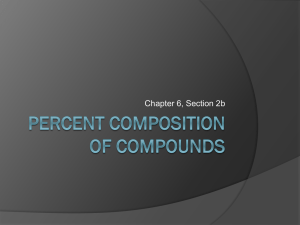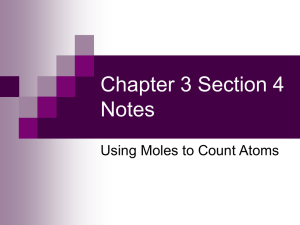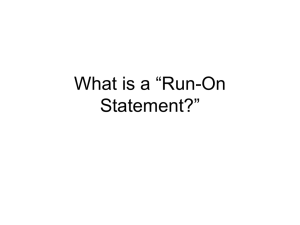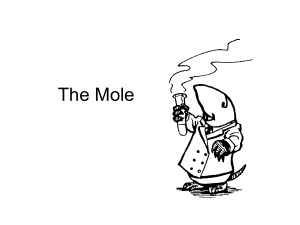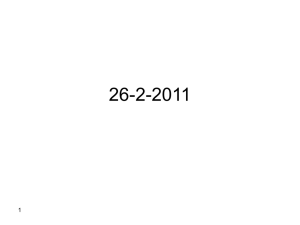Properties of Solutions
advertisement
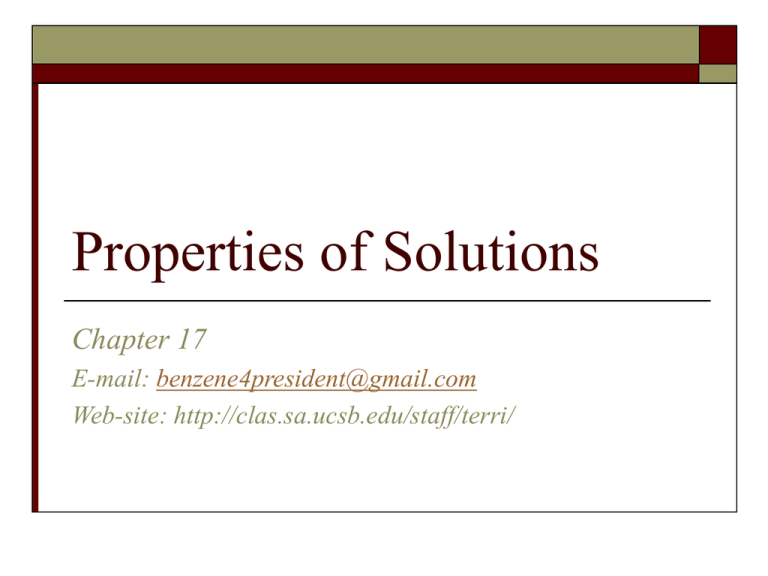
Properties of Solutions Chapter 17 E-mail: benzene4president@gmail.com Web-site: http://clas.sa.ucsb.edu/staff/terri/ Properties of Solutions – ch. 17 1. Predict the relative solubility of the following: a. O2 in H20 vs. O2 in CCl4 b. CH3OH in H2O vs. CH3CH2CH2CH2OH in H2O c. AgCl(s) in H2O at 25°C vs. AgCl(s) in H2O at 45°C d. CO2(g) in C8H18 at 25°C vs. CO2(g) in C8H18 at 45°C e. N2(g) in C6H6(g)at 1 atm vs. N2(g) in C6H6(g)at 8 atm Properties of Solutions – ch. 17 2. What is the molality of an aqueous solution that is 12.5% methanol by weight (molar mass of CH3OH is 32.05 g/mol). Properties of Solutions – ch. 17 3. Calculate the molality and mole fraction of an aqueous solution that is 8 M NaCl, the density of the solution is 1.18 g/ml. Concentrations Molarity ⇒ M = nsolute/Lsolution Molality ⇒ m = nsolute/kgsolvent Mole fraction ⇒ Xa = na/ntotal Properties of Solutions – ch. 17 4. Calculate the heat of hydration for the following ionic solids. a. KF b. RbF c. Compare the ion-dipole forces for K+ vs. Rb+ in H2O Compound Lattice Energy Heat of Solution KF -804 kJ/mol -15 kJ/mol RbF -768 kJ/mol -24 kJ/mol Properties of Solutions – ch. 17 5. A salt solution sits in an open beaker. Assuming constant temperature, the vapor pressure of the solution will… a. increases over time b. decreases over time c. stays the same over time d. We need to know which salt is in the solution to answer this e. We need to know the temperature and pressure to answer this Properties of Solutions – ch. 17 Colligative properties ⇒ the properties of a solution with a non-volatile solute relative to a pure solvent As the concentration of solute particles ↑ vapor pressure ↓ “depression” ⇒ Pa = Xa Pa° freezing point ↓ “depression” ⇒ ΔTf = - kf i m boiling point ↑ “elevation” ⇒ ΔTb = kb i m osmotic pressure ↑ ⇒ π = iMRT i = vant Hoff factor = moles of solute particles moles of solute Properties of Solutions – ch. 17 6. Rank the following aqueous solutions in order of increasing vapor pressure: a. 0.1 M C6H12O6 b. 0.1 M KBr c. 0.05 M Na2SO4 d. 0.05 M CH3COOH Properties of Solutions – ch. 17 7. Calculate the vapor pressure of a solution (in torr) made by dissolving 159 g of ethylene glycol (HOCH2CH2OH – 62.08g/mol) in 500 g of water at 27 °C. At 27 °C the vapor pressure of pure water is 26.7 torr. Properties of Solutions – ch. 17 8. Benzene (C6H6 – 78.12 g/mol) and toluene (C7H8 – 92.15 g/mol) form an ideal solution. What is the vapor pressure of a solution prepared by mixing 40 g of toluene with 15 g of benzene at 25 °C? At 25 °C the vapor pressures of pure toluene and pure benzene are 28 and 95 torr respectively. What is the mole fraction of the benzene in the vapor above the solution? Properties of Solutions – ch. 17 9. Pentane and hexane form an ideal solution. What composition of a pentane and hexane solution at 25 °C would give a vapor pressure of 350 torr? At 25 °C the vapor pressures of pure pentane and hexane are 511 torr and 150 torr respectively. Properties of Solutions – ch. 17 10. After substance A is mixed with substance B the solution feels hotter than before they were mixed. What deviation from Raoult’s Law (if any) would be expected for this solution? a. no deviation b. positive deviation – A and B form stronger forces than pure A and B c. positive deviation – A and B form weaker forces than pure A and B d. negative deviation – A and B form stronger forces than pure A and B e. negative deviation – A and B form weaker forces than pure A and B Properties of Solutions – ch. 17 Ideal vs. Non-Ideal Solutions a. ΔHsol’n ~ 0 ⇒ Ideal solution – the actual vapor pressures will agree with Raoult’s law b. ΔHsol’n > 0 ⇒ Non-Ideal solution – the forces in the solution are weaker than in the pure substances resulting in higher VPs than expected from Raoult’s Law c. ΔHsol’n < 0 ⇒ Non-Ideal solution – the forces in the solution are stronger than in the pure substances resulting in lower VPs than expected from Raoult’s Law Properties of Solutions – ch. 17 11. The vapor pressures of several solutions of water and butanol were determined at various compositions and the data is given below: XH2O VP (torr) 0.00 47.0 0.27 52.5 0.58 58.3 0.72 46.9 1.00 40.2 a. Are the solutions of water and butanol ideal? b. Which of the above solutions would have the lowest boiling point? Properties of Solutions – ch. 17 12. Rank the following aqueous solutions by their boiling points, and freezing points. a. 0.1 M CH2O b. 0.1 M LiF c. 0.05 M (NH4)2SO4 Properties of Solutions – ch. 17 Properties of Solutions – ch. 17 13. Calculate the boiling point and freezing point of a solution made by dissolving 110 g of K3PO4 (212.3g/mol) in 800 mL of water at 1 atm. For water kb = 0.51 °Ckg/mol and kf = 1.86 °Ckg/mol. Properties of Solutions – ch. 17 14. A solution contains 3.75 g of a nonvolatile hydrocarbon in 95 g of acetone. The boiling points of pure acetone and the solution are 55.9 °C and 56.5 °C respectively. What is the molar mass of the hydrocarbon? For acetone the Kb = 1.71 °CKg/mol. Properties of Solutions – ch. 17 15. Calculate the osmotic pressure of a solution made by dissolving 83 g of glucose (C6H12O6) in 100 mL of water at 30 °C. Properties of Solutions – ch. 17 Osmosis ⇒ the diffusion of water thru a semipermeable membrane Osmotic pressure (π )⇒ the minimum pressure that must be applied to keep osmosis from occurring ⇒ π= iMRT ⇒ as the concentration gradient ↑ π↑ Reverse osmosis ⇒ increasing the conc gradient by the movement of water thru a semipermeable membrane by applying a pressure that is > the osmotic pressure Properties of Solutions – ch. 17 16. A solution that contains 29.4 g of non-volatile/non-ionizing solute in 100.8 g of water has a vapor pressure of 25.81 torr at 27 °C. What is the molar mass of the solute? The vapor pressure of water at 27 °C is 26.74 torr. Properties of Solutions – Answers 1. Predict the relative solubility of the following: a. O2 in H20 vs. O2 in CCl4 b. CH3OH in H2O vs. CH3CH2CH2CH2OH in H2O c. AgCl(s) in H2O at 25°C vs. AgCl(s) in H2O at 45°C d. CO2(g) in C8H18 at 25°C vs. CO2(g) in C8H18 at 45°C e. N2(g) in C6H6(g)at 1 atm vs. N2(g) in C6H6(g)at 8 atm 2. What is the molality of an aqueous solution that is 12.5% methanol by weight (molar mass of CH3OH is 32.05 g/mol). 𝑚𝑜𝑙𝑒𝑠 𝑠𝑜𝑙𝑢𝑡𝑒 molality = 𝑘𝑔 𝑜𝑓 𝑠𝑜𝑙𝑣𝑒𝑛𝑡 12.% ⇒ if there’s 100 g of solution 12.5 g of CH3OH and 87.5 g of water 12.5 𝑔 0.39 𝑚𝑜𝑙 mole of CH3OH = 32.05 = 0.39 mol ⇒ m= = 4.46m 𝑔/𝑚𝑜𝑙 0.0875 𝑘𝑔 Properties of Solutions – Answers 3. Calculate the molality and mole fraction of an aqueous solution that is 8 M NaCl, the density of the solution is 1.18 g/ml. (molar mass of NaCl is 58.44 g/mol) 𝑚𝑜𝑙𝑒𝑠 𝑠𝑜𝑙𝑢𝑡𝑒 molality = 𝑘𝑔 𝑜𝑓 𝑠𝑜𝑙𝑣𝑒𝑛𝑡 and 𝑚𝑜𝑙𝑒𝑠 𝑁𝑎𝐶𝑙 mole fraction = 𝑡𝑜𝑡𝑎𝑙 𝑚𝑜𝑙𝑒𝑠 8 M NaCl ⇒ 8 moles of NaCl per 1 L of solution (8 mol NaCl)(58.44 g/mol) = 467.5 g NaCl (1 L of sol’n)(1000mL/L)(1.18 g/L) = 1180 g of sol’n – 467.5g = 712.5 g of water 712.5 𝑔 𝑤𝑎𝑡𝑒𝑟 = 39.5 mol water 18.02 𝑔/𝑚𝑜𝑙 8 𝑚𝑜𝑙 molality = 0.7125 = 11.2 m 𝑘𝑔 8 𝑚𝑜𝑙𝑒𝑠 𝑁𝑎𝐶𝑙 mole fraction= 8+39.5 = 0.168 𝑡𝑜𝑡𝑎𝑙 𝑚𝑜𝑙𝑒𝑠 Properties of Solutions – Answers 4. Calculate the heat of hydration for the following ionic solids. a. KF b. RbF c. Compare the ion-dipole forces for K+ vs. Rb+ in H2O ΔHhydration = ΔHLE + ΔHsol’n KF ⇒ ΔHhydration = (-804kJ/mol) + (-15kJ/mol) = -819kJ/mol RbF ⇒ ΔHhydration = (-768kJ/mol) + (-24kJ/mol) = -792kJ/mol Since both species have fluoride we can compare the ion-dipole forces of K+ vs. Rb+ ⇒ the more negative the heat of hydration the stronger the force ⇒ K+ has the stronger ion-dipole force ⇒ this makes sense since K+ is smaller and can form shorter/stronger bonds with water Properties of Solutions – Answers 5. A salt solution sits in an open beaker. Assuming constant temperature, the vapor pressure of the solution will… b. decreases over time as water evaporates away the concentration of the salt increases causing the VP to decrease 6. Rank the following aqueous solutions in order of increasing vapor pressure: a. 0.1 M C6H12O6 ⇒ i=1 as (conc)x(i) ↑ VP ↓ b. 0.1 M KBr ⇒ i=2 b<c<a<d c. 0.05 M Na2SO4 ⇒ i=3 d. 0.05 M CH3COOH ⇒ i=1 Properties of Solutions – Answers 7. Calculate the vapor pressure of a solution (in torr) made by dissolving 159 g of ethylene glycol (HOCH2CH2OH – 62.08g/mol) in 500 g of water at 27 °C. At 27 °C the vapor pressure of pure water is 26.7 torr. (159g)/(62.08g/mol) = 2.6 mol HOCH2CH2OH (500g)/(18.02g/mol) = 27.7 mol water Pwater = (27.7mol/30.3mol)(26.7torr) = 24.4torr Relative FP or VP => b < c < a < d Relative BP or OP => b > c > a > d Properties of Solutions – Answers 8. Toluene and benzene form an ideal solution. What is the vapor pressure of a solution prepared by mixing 40 g of toluene with 15 g of benzene at 25 °C? At 25 °C the vapor pressures of pure toluene and pure benzene are 28 and 95 torr respectively. (40g)/(92.15g/mol) = 0.43 mol toluene (15g)/(78.12g/mol) = 0.19 mol benzene Ptoluene = (0.43 mol/0.62 mol)(28 torr) = 19.6 torr Pbenzene = (0.19 mol/0.62 mol)(95 torr) = 29.1 torr Psolution = 48.7 torr Properties of Solutions – Answers 9. Pentane and hexane form an ideal solution. What composition of a pentane and hexane solution at 25 °C would give a vapor pressure of 350 torr? At 25 °C the vapor pressures of pure pentane and hexane are 511 torr and 150 torr respectively. Ptotal = Ppentane + Phexane Ptotal = XpPp° + XhPh° Since Xp + Xh = 1 => Xp = 1 – Xh Ptotal = (1 – Xh) Pp° + XhPh° 350 torr = (1 – Xh)(511 torr) + Xh(150 torr) Xh = 0.45 => Xp = 0.55 Properties of Solutions – Answers 10. After substance A is mixed with substance B the solution feels hotter than before they were mixed. What deviation from Raoult’s Law (if any) would be expected for this solution? d. negative deviation – A and B form stronger forces than pure A and B A hotter solution means that the heat of solution was exothermic – the heat given off is due to forming strong forces Properties of Solutions – Answers 11. The vapor pressures of several solutions of water and butanol were determined at various compositions and the data is given below: XH2O VP (torr) 0.00 47.0 0.27 52.5 0.58 58.3 0.72 46.9 1.00 40.2 a. are the solutions of water and butanol ideal? No – since the VP’s of some of the solutions are outside of the range of pure water and pure butanol – since they are outside on the high side the solution will have positive deviations b. which of the above solutions would have the lowest boiling point? Highest VP will result in the lowest BP => XH2O = 0.58 Properties of Solutions – Answers 12. Rank the following aqueous solutions by their boiling points, and freezing points. a. 0.1 M CH2O b. 0.1 M LiF c. 0.05 M (NH4)2SO4 as (conc)x(i) ↑ FP ↓ and BP ↑ Relative FP => b < c < a Relative BP => a < c < b Properties of Solutions – Answers 13. Calculate the boiling point and freezing point of a solution made by dissolving 110 g of K3PO4 (212.3g/mol) in 800 mL of water at 1 atm. For water kb = 0.51 °Ckg/mol and kf = 1.86 °Ckg/mol. (110 g K3PO4)/(212.3g/mol) = 0.52 mol K3PO4 m = 0.52 mol/0.8 kg = 0.65m ΔTf = -(0.65 mol/kg)(4)(1.86 °Ckg/mol) = -4.8°C ΔTb = (0.65 mol/kg)(4)(0.51°Ckg/mol) = 1.3°C Since pure water has a FP = 0°C and BP = 100°C then the solution will have a FP = -4.8°C and BP = 101.3°C Properties of Solutions – Answers 14. A solution contains 3.75 g of a nonvolatile hydrocarbon in 95 g of acetone. The boiling points of pure acetone and the solution are 55.9 °C and 56.5 °C respectively. What is the molar mass of the hydrocarbon? For acetone the Kb = 1.71 °CKg/mol. molar mass = g/mol => given grams and you can get moles from ΔTb = kb i m => mol = ΔTb kgsolvent/ kb i mol = (56.5 °C – 55.9 °C)(0.095kg)/(1.71°CKg/mol)(1) mol = 0.056 molar mass = 3.75g/0.056mol = 66.8g/mol Properties of Solutions – Answers 15. Calculate the osmotic pressure of a solution made by dissolving 83 g of glucose (C6H12O6) in 100 mL of water at 30 °C. π = iMRT π = (1)((83g/180g/mol)/(01.L))(0.08206atmL/molK)(303K) π = 115 atm Properties of Solutions – Answers 16. A solution that contains 29.4 g of non-volatile/non-ionizing solute in 100.8 g of water has a vapor pressure of 25.81 torr at 27 °C. What is the molar mass of the solute? The vapor pressure of water at 27 °C is 26.74 torr. molar mass = g/mol => given grams and you can get moles from Pwater = XwaterPwater° => nsolute = (nwPw°/Pw) – (nw) => nsolute = (100.8g/18g/mol)(26.74torr)/(25.81torr) – (100.8g/18g/mol) nsolute = 0.202 mole molar mass = 29.4g/0.202mol = 146g/mol Properties of Solutions – Answers

